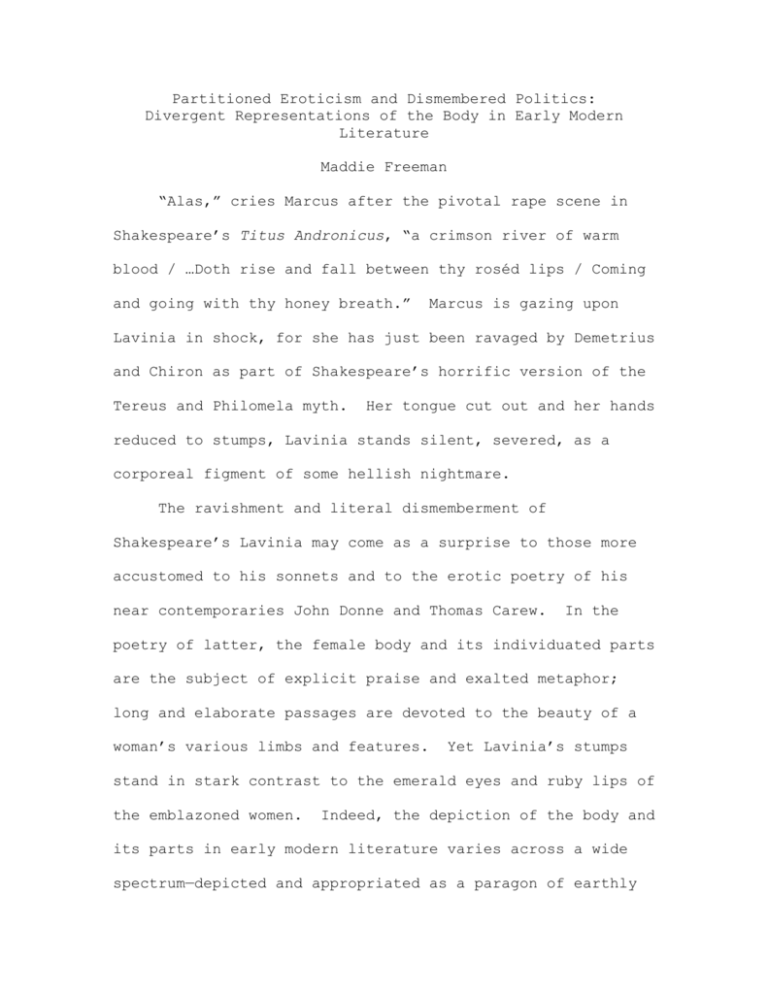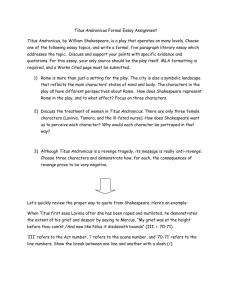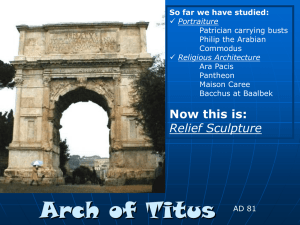
Partitioned Eroticism and Dismembered Politics:
Divergent Representations of the Body in Early Modern
Literature
Maddie Freeman
“Alas,” cries Marcus after the pivotal rape scene in
Shakespeare’s Titus Andronicus, “a crimson river of warm
blood / …Doth rise and fall between thy roséd lips / Coming
and going with thy honey breath.”
Marcus is gazing upon
Lavinia in shock, for she has just been ravaged by Demetrius
and Chiron as part of Shakespeare’s horrific version of the
Tereus and Philomela myth.
Her tongue cut out and her hands
reduced to stumps, Lavinia stands silent, severed, as a
corporeal figment of some hellish nightmare.
The ravishment and literal dismemberment of
Shakespeare’s Lavinia may come as a surprise to those more
accustomed to his sonnets and to the erotic poetry of his
near contemporaries John Donne and Thomas Carew.
In the
poetry of latter, the female body and its individuated parts
are the subject of explicit praise and exalted metaphor;
long and elaborate passages are devoted to the beauty of a
woman’s various limbs and features.
Yet Lavinia’s stumps
stand in stark contrast to the emerald eyes and ruby lips of
the emblazoned women.
Indeed, the depiction of the body and
its parts in early modern literature varies across a wide
spectrum—depicted and appropriated as a paragon of earthly
beauty, as a vessel for the release of desire (to put it
mildly), as a tool of political alliance and warfare—but the
contrast between the poetically emblazoned women and the
dramatically maimed Lavinia is particularly significant.
These clashing images represent a dissonant theme of bodily
representation in early modern literature: while the
metaphoric partitioning of the body is erotic, the literal
dismemberment of the body carries negative moral and
political implications.
In other words, early modern poets
and playwrights appropriated the body for different
purposes, and it is the extent to which they divided up the
body that reveals these purposes.
In this essay I will
examine these themes by drawing primarily from Titus
Andronicus and the aforementioned poetry of Donne and Carew,
with support from several other early modern poems and
plays.
It is useful to examine how the metaphorically
partitioned female body was and was not eroticized in the
poetry of the time. In their poems “Hero and Leander” and “A
Rapture,” Christopher Marlowe and Thomas Carew muse on love
and sex unfettered by the chains of honor.
They both sing
the praises of their respective Hero and Celia, but the
poems differ significantly in describing these women.
Consider the following excerpt of “Hero and Leander”:
2
At Sestos Hero dwelt; Hero the fair,
Whom young Apollo courted for her hair…
The outside of her garments were of lawn,
The lining purple silk, with gilt stars drawn…
Her kirtle blue, whereon was many a stain,
Made with the blood of wretched lovers slain.
Upon her head she ware a myrtle wreath,
From whence her veil reached to the ground beneath.
(Marlowe 5-18)
and compare it to Carew’s description of what he will do
with “his Celia” in “A Rapture”:
I’ll seize the rosebuds in their perfumed bed,
The violet knots, like curious mazes spread
O’er all the garden, taste the ripened cherry,
The warm, firm apple, tipped with coral berry.
Then will I visit with a wandering kiss
The vale of lilies and the bower of bliss…
(Carew 63-68)
Marlowe’s poem is notably less erotic than Carew’s.
In lieu
of Hero’s body, Marlowe concentrates on her clothing, and
this perhaps foretells the fact that Hero never becomes much
of an erotic figure at all.
In the last scene of the poem,
when Leander has finally made it to Hero’s bed, she “plays
the Harpy” as he seduces her, ultimately becoming a “poor
silly maiden” when she is “at his mercy” (754, 770).
After
the sexual act Hero falls “mermaid-like” out of bed as she
attempts to get away and blushes as her naked body is
displayed to Leander as an “orient cloud” inopportunely
illuminates the room (799, 804).
I would argue that
Marlowe’s original description of Hero is related to the
3
fact that this scene is so completely unerotic, and this
lack becomes particularly evident when one examines the
description alongside the Carew excerpt.
“A Rapture” is
“probably the most erotic poem of the era,” according to the
Norton Anthology, and much of its eroticism derives from the
blazoning of Celia’s body.
In the Carew passage quoted
above, the narrator’s kisses travel over her body as its
parts are described through an Edenic conceit; Celia’s body
is turned into a garden of erotic delights, and describing
it bit by bit, from her “unbraided gold” to her “virgin
treasure,” is essential in making “A Rapture” erotic.
Had
Marlowe similarly blazoned Hero’s body instead of describing
her garments, one could reasonably expect those body parts
to play a significant erotic role in the final scene.
Instead her clothing is blazoned in an attempt to preempt
and mitigate the eroticism, for with “Hero and Leander”
Marlowe aims not for a sexual paradise but a sexual paradox—
despite their beauty, in the end Hero and Leander are
subject to human weaknesses and shortcomings.
John Donne’s “Elegy XVIII,” also known as “Loves
Progresse” (and sometimes recorded as “Elegy XIX”) is
without a doubt meant to be erotic.
According to Jonathan
Sawday in his book The Body Emblazoned, the poem is “an
erotic voyage of discovery down the female body which
4
finally encounters the object of desire,” i.e., the vagina
(205).
As he “sail[s] toward her India,” Donne partitions
the body as one partitions a map:
The hair a forest is of ambushes,
Of springes, snares, fetters, and manacles;
The brow becalms us when ‘tis smooth and plain,
And when ‘tis wrinkled, shipwrecks us again….
The nose, like to the first meridian, runs
Not ‘twixt an east and west, but ‘twixt two suns;
It leaves a cheek, a rosy hemisphere,
On either side, and then directs us where
Upon the islands fortunate we fall,
Not faint Canaries, but ambrosial,
Her swelling lips, to which when we are come,
We anchor there, and think ourselves at home….
These and the glorious promontory, her chin,
O’erpast, and the straight Hellespont between
The Sestos and Abydos of her breasts,
Not of two lovers, but two loves, the nests,
Succeeds a boundless sea, but yet thine eye
Some island moles may scattered there descry;
And sailing towards her India, in that way
Shall at her fair Atlantic navel stay.
As in “A Rapture,” it is the act of traversing this
landscape rather than gazing at it that makes the poem
erotic.
Reading this poem simulates the sexual act
itself; one can imagine hands and kisses moving over
the body and lingering at the face, the breasts, the
navel.
This conceit is particularly effective because
it recalls the tradition of “divide and conquer,” that
ultimate feat of virile masculinity and empire.
“At
heart,” writes Sawday, “the [poets’] goal was conquest,
the end result a mocking male laughter at the ways in
5
which a courtly language of adoration could be deployed
to such purely physical ends” (205).
By partitioning
the body through the conceit of discovery, the exalted
terminology of imperial conquest joins this “courtly
language of adoration” to produce an erotic text that
celebrates sexual subjugation and machismo.
Yet Carew and Donne are not without their
precursors, for no study of the eroticized body in
early modern literature would be complete without a
discussion of the French blasonneurs.
While Carew and
Donne celebrate the female form in all of its sexual
glory, their sixteenth-century French forebears note
the feminine features as one might discuss an artwork,
typically concentrating on one body part at a time.
They take the metaphoric partitioning of the body to
its extreme, and indeed the female body is seen as
beautiful and erotic primarily because it can be
divided into discrete parts that are themselves
beautiful.
To wit:
Well formed breast, whiter than an egg,
Breast of brand new white satin,
Breast which puts the rose to shame,
Breast more beautiful than anything.
This excerpt from Clement Marot’s 1535 “Blason de beau
tetin” along with the many other blazons written soon
6
afterward constitute a lyric catalogue of female parts
as seen through the eyes of men, and it is here that
female parts can really be emphasized.
In her essay
“Members Only: Marot’s Anatomical Blazons,” Nancy
Vickers notes that the blazon poets “diminished
synecdoche” by minimizing the implication of a whole
female body.
Blazoned parts include the heart, the
mouth, the thigh, the ear, but, unlike their later
English counterparts, the blasonneurs typically make no
mention of a woman to whom these parts belong.
Each of
these parts has its own qualities of beauty and, often,
eroticism, but the woman herself is not a salient
figure.
As Vickers says, “[T]he addressee [i]s not a
whole woman but, rather, a part of a woman—a nose, or a
tooth, or a hand” (4).
Thus, although the English
poets added narrative and conceit to the genre, one
might say that the tradition of metaphoric bodily
partitioning reaches its apotheosis with these original
French blasons.
It is the English, however, who cross the lines of
metaphor and enter the realm of literal dismemberment.
This move also requires a transition between genres;
the literal dismemberment of the body occurs primarily
in those works written for the stage.
In his essay
7
“The Aesthetics of Mutilation in Titus Andronicus,”
Albert H. Tricomi articulates this metamorphosis from
the imagined to the real: “The figurative language [of
Titus Andronicus]…imitates the gruesome circumstances
of the plot” (11).
The physical reality of linguistic
image is absent from poetry; indeed, it is only on the
stage that this theme can be explored.
By staging the
literal dismemberment of the body, Shakespeare and his
cohorts co-opt the poetic mode of bodily representation
and take it to its most visceral extreme; instead of
idealizing figures in the vein of Celia and Hero, they
use the stage as a showcase of raw humanity, where the
body is not exalted but appropriated as a tool of
warfare and intrigue.
Whereas the poets partitioned
the body for erotic purposes, Shakespeare, John
Webster, and Thomas Middleton and William Rowley
dismember the body in order to further social and
political motifs.
In Titus Andronicus, bodily dismemberment occurs
no later than the first scene; Titus and his son Lucius
call on their prisoners, the Goths, to give over one of
their number, “That we may hew his limbs, and on a pile
/ Ad manes fratrum sacrifice his flesh” (I.i.97-8).
Alarbus, the son of Tamora, Queen of the Goths, is
8
selected for this bloody rite of revenge, and despite
Tamora’s protests his “limbs are lopped” without
further ado.
This initial act of dismemberment
literally sets the stage for that which is to follow:
the political upheaval of the fragmented Roman state
will be played out through the “fragmenting” of its
constituent bodies.
Marcus does not know the gravity
of his words when he tells his brother Titus to “Be
candidatus then, and put [this palliament] on / And
help to set a head on headless Rome” (I.i.185-6).
This
image of Rome as “headless” is a sign of the disunity
that will only escalate over the next four acts; the
various rivaling factions will trade barbs, limbs, and,
ultimately, life in the struggle for justice within the
Roman state.
The first act ends with Titus and the other
Senators mutually agreeing to elect Saturninus as
Rome’s new emperor, and Titus invites Saturninus and
his party on a hunting trip as a gesture of goodwill.
It does not take long, however, for rancor to erupt
between these two parties.
Tamora is now Saturninus’s
wife, and she is bitter over the loss of her son and
station.
With these injustices in mind, she plots with
her cohort and secret lover Aaron to create a rift
9
between Titus and Saturninus.
They lure Saturninus’s
brother Bassianus and his wife Lavinia, Titus’s
daughter, into a secluded part of the forest during the
hunting expedition, and it is here that the wheels of
upheaval begin turning.
This scene features the play’s
most barbaric act, an act that turns its mythic
precursor on its head and sets the bar for the atrocity
of the crimes that will ensue.
Tamora goads her sons
Demetrius and Chiron into killing Bassianus, and in
order to exact greater revenge she gives them license
to rape Lavinia.
In fact, she encourages this rape:
“The worse to her, the better loved of me,” she says
(II.iii.167).
Lavinia survives this torture, but she does not
remain intact.
Her hands are cut off and her tongue is
cut out to prevent her from telling anyone, and it is
thus that she becomes a symbol of the bloodthirsty
malice and fragmentation among the people of Rome.
Yet
her dismemberment is especially salient for the bodily
motif that it introduces.
In her article “Dismembering
and Forgetting in Titus Andronicus,” Katharine A. Rowe
examines the metaphoric and literal use of hands as
they appear within the play.
“The severed hand,” she
says, “calls for attention as an instance of
10
dismemberment particular in itself, with its own
iconographic and social history, connected to the
complex visual imagery of the body politic” (279-80).
Rowe traces Galen’s theories on the functions of the
hand and Hobbes’s theories on agency as articulated in
the Leviathan, and reaches this conclusion: “If hands
are a common motif for action, they are…parts that
should be ‘taken severally’ (or severed) rather than as
part of a whole in representing agency” (284).
To this
I would add that hands are turned into a form of
“currency” that Titus and Saturninus use as a mode of
leveraging agency and power, as is evidenced by the
ways in which they attempt to even the score after each
injustice.
After Saturninus discovers Bassianus’s body in a
ditch in the forest, his blame falls not on Tamora or
Aaron but on two sons of Titus, Quintus and Martius,
who fell into the ditch after Aaron turned it into a
trap for them.
Thus Saturninus captures Quintus and
Martius in order to exact revenge on Titus, and what
follows is perhaps the most significant and unambiguous
example of the dismemberment motif and the “trade” of
body parts.
Aaron, acting as the messenger of
11
Saturninus, tells Titus, Marcus, and Lucius (another
son of Titus) that the emperor is offering a deal:
Let Marcus, Lucius, or thyself, old Titus,
Or any one of you, chop off your hand
And send it to the King: he for the same
Will send thee hither both thy sons alive,
And that shall be ransom for their fault.
This trade, while cruel, also allows Titus to play the hero.
He assumes an air of nobility and lets Aaron chop off his
hand for ransom.
Yet this only serves to give Saturninus a
boost in the power struggle; Titus’s lopped off hand is now
nothing but a successfully dismembered fragment of his
crumbling political body.
To make matters worse, the deal
itself is but a trick: a messenger soon approaches Titus
with “the heads of thy two noble sons / And…thy hand in
scorn to thee sent back / Thy grief their sports, thy
resolution mocked” (III.i.236-8).
If honor is the order of
the day, then body parts are the currency with which it is
won and lost.
Only Marcus seems to recognize the gross
magnitude of this gruesome sparring between Titus and
Saturninus and Tamora; after much blood is shed he cries,
“O, let me teach you how to knit again / This scattered corn
into one mutual sheaf / These broken limbs again into one
body” (V.iii.70-2).
Yet this “one body” can only manifest itself when power
changes hands completely (pun intended).
The next
12
generation of Roman statesmen is the means of survival, and
even though Titus (and Saturninus and Lavinia and Tamora)
wind up dead, the Andronici family does prevail in the end,
for Lucius is declared emperor.
As a first order of
business he punishes Aaron, the “breeder of these dire
events.”
Set him breast-deep in earth and famish him;
There let him stand and race and cry for food:
If anyone relieves or pities him,
For the offense he dies. This is our doom.
Some stay, to see him fast’ned in the earth.
(V.iii.178-83)
This conclusion is an ironic twist on Marcus’s original call
for “a head on headless Rome.”
With Aaron buried deep in
the ground and only his head visible above the earth, this
head on the formerly “headless Rome” is not the symbol of
power that Marcus intended but a corporeal reminder of the
dangers of political bodies that devolve into barbarism.
By
transforming a splintering body politic into literally
dismembered bodies, Shakespeare manages to turn the
civilized into the barbaric and the metaphoric into the
literal, bridging “the chasm between the spoken word and the
actual fact” with chilling results (Tricomi 13).
Titus Andronicus is by no means the only play to
exhibit such dismemberment and exchange of parts.
Just as
the poems of Marlowe, Carew, Donne, and the blasonneurs
13
evince similar modes of bodily representation and eroticism,
so do other Renaissance-era plays use body parts as the
corporeal manifestation of social and political anxieties.
The Changeling by Thomas Middleton and William Rowley is one
such play.
It concerns a woman arranged to marry a man
against her wishes; at the behest of her father BeatriceJoanna is engaged to one Alonzo de Piracquo, a harmless but
ultimately uninteresting suitor.
Her romantic attachment
instead lies with Alsemero, whom she meets soon after her
engagement to Piracquo: “This was the man that was meant
me,” she mourns, “that he should come / So near his time,
and miss it!” (I.i.81-2).
With little means of escape,
Beatrice is forced to call upon the one man she truly
detests for help.
This man is DeFlores, her father’s servant, and he is
madly in love with Beatrice.
Eager to be in her good
graces, DeFlores immediately accepts her request that he
dispose of Piracquo, and in short order he confronts
Piracquo and stabs him with a rapier.
The scene is a quick
one and for the most part it is a clean killing, but it is
what DeFlores does immediately after he kills Piracquo that
warrants special attention.
About to seal Piracquo’s body
within a vault, DeFlores spies a ring upon his dead finger:
14
…Ha! what’s that
Threw sparkles in my eye?—Oh, ‘tis a diamond
He wears upon his finger. It was well found:
This will approve the work. What, so fast on?
Not part in death? I’ll take the speedy course then:
Finger and all shall off.
(III.i.30-5)
Without hesitation he chops off Piracquo’s hand in order to
save the ring that stubbornly stays attached.
When he later
tells Beatrice that the deed has been done, she is overjoyed
to find out that Piracquo has been done away with; she now
believes that she and Alsemero are free to pursue their
love.
But this scene is also a grim twist on the aborted
marriage vows—when DeFlores flourishes Piracquo’s hand as
proof, he is also presenting Beatrice with the hand she was
supposed to take in marriage.
Except now, of course, it is
dead hand, and as a sort of gruesome joke Beatrice only
accepts Piracquo’s hand—
complete with ring—after he has expired.
The conniving
DeFlores has something more up his sleeve; this hand also
symbolizes the debauched request that he will make of
Beatrice.
As payment for the favor he performed, he wants
more: “If I enjoy thee not, thou ne’er enjoy’st / I’ll blast
the hopes and joys of marriage / I’ll confess all—my life I
rate at nothing” (III.iii.147-9).
If Beatrice does not
sleep with him, DeFlores will confess his deed and Beatrice
will be culpable.
Thus the dead hand he proffers is a
15
corporeal sign of what Beatrice will endure; the rape of her
virgin body, a bastardized form of the consummation rites.
This hand, like the hands in Titus Andronicus, serves
to carry out an ignoble purpose.
Whereas it was politics
and civility on the line in Titus, in The Changeling it is
Beatrice’s “dear companion of [her] soul / Virginity, whom
[she] thus long [has] lived with” (I.i.86-7).
The
dismembered body is now becomes a symbol of depraved
sexuality, and this theme recurs in John Webster’s drama The
Duchess of Malfi.
This drama involves Ferdinand, a “perverse and
turbulent” duke who verges on the edge of insanity
(I.ii.76).
He is driven all the more mad when he finds out
that his sister, the eponymous Duchess, has married a man of
lower rank, without his knowledge.
Afraid that he has lost
out on his share of the Duchess’s inheritance, Ferdinand
begins a campaign of sibling warfare; he locks up the
Duchess and tries to drive her to despair by telling her
that her husband and sons are dead.
As proof he gives the
Duchess a dead man’s hand that bears a ring upon its finger,
much like the hand in The Changeling:
I will leave this ring with you for a lovetoken,
And the hand as sure as the ring; and do not doubt
But you shall have the heart, too. When you need a
friend,
16
Send it to him that owed it; you shall see
Whether he can aid you.
These words are not only cruel but false as well.
The hand
is not her husband’s at all; Ferdinand is trying to trick
the Duchess.
But there is something else going on under the
surface of this scene–at this point in the play the audience
or reader understands that Ferdinand’s jealousy extends
beyond the bounds of any typical sibling rivalry.
His
anxiety seems to be of a sexual nature, for his extreme
jealousy of her unknown husband hints at a desire to be in
his place.
Thus one could interpret this proffered hand as
a phallic symbol, a symbol of Ferdinand’s repressed
incestuous desire.
“When you need a friend / Send it to him
that ow[n]ed it,” he says.
While he is ostensibly referring
to Antonio, the Duchess’s husband, it is in fact Ferdinand
himself who “owns” this hand because the audience is never
made aware of its origins.
As in The Changeling, the
offering of this hand is a form of offering one’s hand in
marriage, a marriage that is debased, bastardized, driven by
perverse sexuality.
Thus these three plays appropriate the body and its
parts in order to signal some sort of depravity in man.
For
Shakespeare it is a barbaric depravity, a force that drives
Roman statesmen to dismemberment and murder.
For Middleton,
17
Rowley, and Webster it is a sexual depravity, a force that
compels men to lose control of their base desires.
The
dismemberment of the body is a gruesome thing, and when this
is manifested literally—on the stage, no less—it seems
appropriate that it should stand as a symbol of some hellish
reality.
For the poets, the bodies they partition are less
corporeal than ethereal, and accordingly the language they
use is exalted, often evocative of the heavenly, the divine.
With this in mind, these disparate structures—the
dismembered body vs. the partitioned body, the corporeal vs.
the ethereal, the stage vs. the page—can be seen as a means
of inquiring into that divide between the body and soul.
The playwrights and the poets, like many others during the
Renaissance era, constantly struggled with this perceived
schism between body and soul.
To be embodied is to be
debased, according to some; by partitioning the body
literally and metaphorically the artists are able to make
some sense of these complex notions.
They use the body as a
recognizable motif in order to explore questions that cannot
quite be articulated in words.
Thus we are given a “body”
of work that presents two different but not mutually
exclusive representations of the human form: one that is
hellishly dismembered and manipulated and another that is
boundless, divine, and the sum of beautiful parts.
18
Works Cited
Carew, Thomas.
“A Rapture.” Greenblatt and Abrams 1672-5.
Donne, John. “Elegy 19.” Luminarium: Anthology of English
Literature.
<http://http://www.luminarium.org/sevenlit/donne/elegy1
9.php>.
Greenblatt, Stephen and M.H.
Abrams, eds. The Norton
Anthology of English Literature. New
York: W.W. Norton, 2006. 8th Ed, V.I.
Marlowe, Christopher.
“Hero and Leander.” Greenblatt and
Abrams 1004-22.
Middleton, Thomas, and William Rowley. The Changeling. New
York: A & C Black,
2007.
Pike, Robert E. “The ‘Blasons’ in French Literature of the
16th Century. ” The Romanic
Review XXVII (1936): 234.
Rowe, Katherine A. “Dismembering and Forgetting in Titus
Andronicus. ” Shakespeare
Quarterly 45 (1994): 279-303.
JSTOR. Seymour Library. 10 Nov. 2008
19
<http://www.jstor.org/stable/2871232>.
Sawday, Jonathan.
The Body Emblazoned: Dissection and the
Human Body in Renaissance Culture.
New York: Routledge, 1995.
191-212.
Shakespeare, William. Titus Adronicus and Timon of Athens.
Ed. Sylvan Barnet and
Maurice Charney. New York: Signet
Classics, 2005. 16-109.
Tricomi, Albert H. “The Aesthetics of Mutilation in Titus
Andronicus. ” Ed. Kenneth
Muir. Shakespeare Survey 27
(1974): 11-19.
Vickers, Nancy J.
Blazons.”
“Members Only: Marot’s Anatomical
The Body in Parts: Fantasies of Corporeality in
Early Modern Europe.
Mazzio.
Eds. David Hillman and Carla
New York:
Routledge, 1997.
3-21.
Webster, John. The Duchess of Malfi. Greenblatt and Abrams
1462-1535.
20








